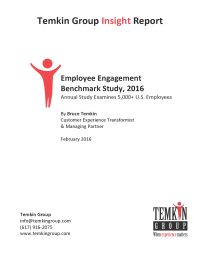Report: Employee Engagement Benchmark Study, 2016
February 16, 2016 Leave a comment
 We just published a Temkin Group report, Employee Engagement Benchmark Study, 2016. This is the fifth year that we’ve published the benchmark of U.S. employees. The research is based on an online survey on Q3 2015. (Take a look at our Employee Engagement Resource Page).
We just published a Temkin Group report, Employee Engagement Benchmark Study, 2016. This is the fifth year that we’ve published the benchmark of U.S. employees. The research is based on an online survey on Q3 2015. (Take a look at our Employee Engagement Resource Page).
Here’s the executive summary: We used the Temkin Employee Engagement Index to analyze the engagement levels of more than 5,000 U.S. employees. We found that employee engagement has stayed relatively flat since last year, but engagement levels still vary by organization, industry, and individual. Companies with stronger financial performances and better customer experience have employees who are considerably more engaged than their peers. Our research also shows that out of all the industries, the construction sector has the highest percentage of engaged employees, while the retail sector increased the most since last year. We additionally found that companies with 501 to 1,000 employees have the highest percentage of engaged employees and companies with 10,000 or more employees have the lowest level of engagement. On an individual level, our research shows that employees who are highly educated, high-income earners, executives, male, and have very good bosses tend to be the most highly engaged. Given the significant value of engaged employees, we recommend that companies improve engagement levels by mastering our Five I’s of Employee Engagement: Inform, Inspire, Instruct, Involve, and Incent.
Here’s what we found when we examined year-over-year results for the Temkin Employee Engagement Index:
Here are some other findings from the research:
- 77% of employees in companies that have significantly better financial performance than their peers are highly or moderately engaged, compared with only 49% of employees in companies with lagging financial performance.
- Customer experience leaders have 1.5 times as many engaged employees as do customer experience laggards.
- Compared with disengaged employees, highly engaged employees are more than four times as likely to recommend the company’s products and services and do something good for the company that is not expected of them, 2.5 times as likely to stay at work late if something needs to be done after the normal workday ends, and seven times as likely to recommend that a friend or relative apply for a job at their company.
- 63% of highly engaged employees always try their hardest at work, compared with 42% of disengaged employees.
- Companies with 500 to 1,000 employees have the most engaged employees, while those with more than 10,000 employees have the least.
- 25- to 34-year-old employees are the most engaged group, while 45- to 54-year-old employees are the least engaged.
- Senior executives are 1.6 times more likely than individual contributors to be highly or moderately engaged.
- Of the 15 industries measured in the study, construction has the highest level of moderately and highly engaged employees (71%).
The bottom line: Engaged employees are the start to may good things
